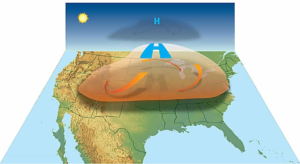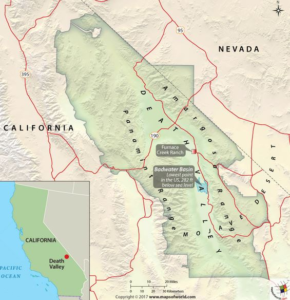In News
- The death valley had recorded a temperature of 129°f in july 2013.the temperature on august 16 has surpassed it
Previous records
- However, since the temperature-recording mechanism was not as advanced, many have doubted if that reading was reliable.
- Similarly, a reading of 131°f or 55°c from july 1931 in Tunisia, has also been challenged.
- The high temperature recorded on august 16 is a result of a so-called ‘heat dome’ .
What Is A Heat Dome?
- A heat dome occurs when the atmosphere traps hot ocean air like a lid or cap
- Summertime means hot weather — and extreme heat waves have become more frequent in recent decades.
- Sometimes, the scorching heat is ensnared in what is called a heat dome.
- High-pressure circulation in the atmosphere acts like a dome or cap, trapping heat at the surface and favoring the formation of a heat wave.

Causes
- This happens when strong, high-pressure atmospheric conditions combine with influences from La Niña.
- This creates vast areas of sweltering heat that gets trapped under the high-pressure “dome“.
- The main cause is a strong change (or gradient) in ocean temperatures from west to east in the tropical Pacific Ocean
- Western Pacific’s temperatures have risen over the past few decades as compared to the eastern Pacific, creating a strong temperature gradient.
- Alternatively, these pressure differences drive wind, across the entire ocean in winter.
Principle
- In a process known as convection, the gradient causes more warm air, heated by the ocean surface.
- This rises over the western Pacific, and decreases convection over the central and eastern Pacific.
- As prevailing winds move the hot air east, the northern shifts of the jet stream trap the air.
- Thus winds move it toward land, where it sinks, resulting in heat waves.
Ocean Mean Temperature (Omt)
- These are important climatic parameters required for atmospheric and oceanic studies like cyclone and monsoon predictions .
- The aim here is to calculate ocean heat transport estimations.
- The data used to estimate these parameters are :
- sea surface height anomaly (SSHA) from the available altimeters
- sea surface temperature (SST)
Death Valley and its location
- Death Valley is a desert valley in Eastern California, in the northern Mojave Desert, bordering the Great Basin Desert.
- It is one of the hottest places on Earth, along with deserts in the Middle East and the Sahara.
- The valley is extremely dry because it lies in the rain shadow of four major mountain ranges (including the Sierra Nevada and the Panamint Range).
- Moisture moving inland from the Pacific Ocean must pass eastward over the mountains to reach Death Valley; as air masses are forced upward by each range, they cool and moisture condenses, to fall as rain or snow on the western slopes.
- When the air masses reach Death Valley, most of the moisture has already been lost and there is little left to fall as precipitation.

Key factors leading to its high temperature
- Solar heating: The valley’s surface (consisting of soil, rocks, sand, etc.) undergoes intense solar heating because the air is clear and dry, and the land is dark and sparsely vegetated. This is especially noticeable in summer when the sun is nearly directly overhead.
- Trapping of warm air: Warm air naturally rises and cools; in Death Valley, this air is subject to continual reheating as it is trapped by high, steep valley walls and recycled back to the valley floor.
- Migration of warm air from other areas (advection): Warm desert regions adjacent to Death Valley, especially to the south and east, often heat air before it arrives in Death Valley.
- Warm mountain winds: As winds are forced up and over mountains (e.g., the numerous ranges west of Death Valley), the winds can be warmed in several ways. The resulting dry, warm winds are known as foehn winds.
















